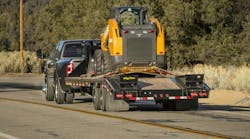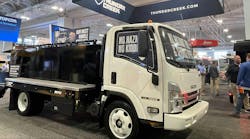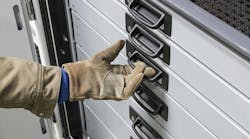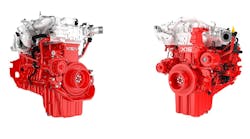While most items that require attachment to a truck's frame are dealt with at the factory, installing a dump body or other equipment on a new truck, or retrofitting an older truck, can raise some questions regarding the proper techniques.
In spite of advances in manufacturing processes, aftermarket modification of truck frame rails must still follow strict guidelines to prevent damage and loss of warranty. Even changes as simple as drilling bolt holes or cutting excess length from the rear of the frame can have an adverse effect.
Because there are several types of frame rails used on today's worktrucks, it's important to determine the specific variety used, and then follow the manufacturer's guidelines for the required modification. Three basic types of frame rails used on most larger trucks, and a fourth variety is becoming increasingly popular in the light-duty range.
On heavy-duty trucks, frame rails are available in either aluminum or steel, typically formed into a "C" channel, or three-sided box comprised of a large, flat "web" (vertical) with narrower "flanges" (horizontal) at the top and bottom of the web. The steel frames are either heat-treated during the manufacturing process to add additional strength without additional weight, or left untreated. In severe service applications, a second "C" channel may be nested inside or outside all or part of the main frame rail for extra strength.
On many light trucks, two C-channel sections are sometimes welded together, forming a box section that provides increased strength without the added vehicle height that would be required to accommodate a single C-channel of equal strength. Many light-duty OEMs have adopted a "hydroforming" process, where a round, seamless tube is filled with liquid at an enormously high pressure, causing the tubing to expand into the complex shape of the form surrounding it. This avoids the cost and weight involved with creating a welded box section frame.
Among the four varieties described, the heat-treated steel frame is the most sensitive to improper modifications. However, this type of frame is also the most common, due to its high strength-to-weight ratio.
Any cutting or welding can heat the frame rail enough to affect the factory heat-treating in the area around the modification. The result of improper modification can range from the loss of heat-treating, or softening, to adding too much heat-treating, making the metal more brittle. The relative location of drilled holes and metal-finishing of a modification can also lead to cracking as the frame is subjected to normal operational stresses.
Ideally, any work involving modification of a frame rail should be performed by an OEM dealer's shop or a qualified body installation company. If the work on the frame is to be performed in a fleet's own shop, acquiring a copy of the OEM maintenance manual and/or body builder manual for that specific truck model is an absolute necessity. Each manufacturer provides explicit instructions and precautions regarding frame modification. Failing to adhere to the manufacturer's procedures will generally void part or all of the chassis warranty.
The following guidelines are general and not specific to any single manufacturer or type of frame, nor are they all-inclusive. Again, consult the OEM maintenance/body builder manual for each specific model before attempting any frame modification.
Drilling- Never drill holes in the frame rail's upper or lower flange.
- Do not drill holes immediately adjacent to existing holes. Check OEM spec's for minimum spacing.
- Do not drill holes in the frame rail web area adjacent to the upper and lower flanges.
- Check OEM spec's for minimum spacing.
- Do not scribe the drilling location beyond the diameter of the hole to be drilled.
- Use a drill of sufficient size to provide the recommended clearance for fasteners.
- Do not use a torch to create a hole in the frame rail.
- Check the opposite side of the frame rail area being drilled for wires, hoses and other hardware.
- Turn off the truck's key switch.
- Attach the welding ground lead as close to the weld point as possible.
- Do not attach the ground lead in such a manner that current must pass through any bearings or rotating surfaces to complete the welding circuit.
- Isolate the vehicle batteries and electronic control units prior to any electrical welding procedure (TIG, MIG, Arc, Resistance) by disconnecting the main positive and negative battery cables, as well as the control unit connectors.
- Remove any hoses, wires or other components from the area of the frame to be welded.
- Non-heat-treated steel frames should only be welded using a "shielded arc" (MIG) welding process.
- Aluminum frames should only be welded using a "tungsten inert gas" (TIG) welding process.
- Pre-heating of the weld area is generally recommended on aluminum frames.
- Thoroughly clean and strip all surfaces in the area of the weld to prevent contamination.
- Follow the truck manufacturer's specific recommendations for the proper welding electrodes.
- Corners must be radiused and cut surfaces must be ground smooth to prevent the propagation of cracks.
- Allow a sufficient margin to permit grinding away any material affected by the heat of the cutting process.
- Provide adequate quenching during the cutting process to minimize warping from heat.
- Do not flame-cut aluminum frame rails.
It is important to diagnose the root cause of a frame crack before making repairs to the frame. Cracks are usually caused by excessive shock-loading of the frame. Typical sources of this problem include loose suspension and body mounting brackets, or worn isolation cushions in the cab attachment points or motor mounts.
Welding a frame rail without eliminating the cause of the damage will usually result in a new crack, right next to the welded repair. This is frequently misdiagnosed as an improper weld, but the weld is generally stronger than the original rail, so the shock-load force inputs that caused the initial crack are directed to the nearest weaker area, right next to the weld.




